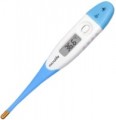Measurement range
The range of temperatures that a thermometer can measure.
For measuring body temperature, a range of 35 – 43 °C is considered ample, covering values encountered in individuals with high fever or hypothermia. Although modern medical thermometers may have broader ranges, especially those designed for water and air temperature measurement (e.g., -20 – 100 °C), when used for body temperature, they typically operate within a narrower range. The overall and "solid" measurement ranges are often specified separately in these thermometers.
Flexible tip
The presence of a
flexible tip in the design. This feature is characteristic only for contact models (see "Type") — it is not required for an IR thermometer. A flexible tip can in some cases simplify the use of the thermometer (particularly for rectal measurements) and also reduce the risk of breakage (for example, a small child trying to break the device will only bend it instead).
Case included
The presence of a
case, mostly plastic to avoid damage to the device during storage or transportation.
Power source
Type of batteries used in thermometers.
— AA. The ubiquitous battery, commonly found everywhere batteries are sold, operates at 1.5 volts, making it widely accessible.
— AAA. The batteries, which are a compact alternative to AA batteries with the same 1.5V voltage, are widely used and suitable for small devices.
— CR2032. One of the most popular types of batteries, with a diameter of 20 mm and a thickness of 3.2 mm. Actual for use in compact devices.

